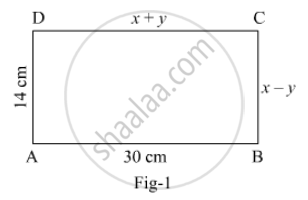Advertisements
Advertisements
Question
A two-digit number is 4 times the sum of its digits. If 18 is added to the number, the digits are reversed. Find the number.
Solution
Let the digits at units and tens place of the given number be x and y respectively. Thus, the number is ` 10 y + x`.
The number is 4 times the sum of the two digits. Thus, we have
` 10 y + x = 4 ( x + y)`
` ⇒ 10 y + x = 4x + 4 y `
`⇒ 4 x + 4 y - 10 y - x = 0 `
`⇒ 3 x - 6 y = 0 `
`⇒ 3( x - 2y)= 0`
` ⇒ x - 2y =0`
After interchanging the digits, the number becomes `10x + y .`.
If 18 is added to the number, the digits are reversed. Thus, we have
`(10 y + x )+ 18 =10x + y`
`⇒ 10 x + y -10y -x =18`
` ⇒ 9x -9y =18`
` ⇒ 9(x -y) = 18`
` ⇒ x - y= 18/9`
`⇒ x - y = 2`
So, we have the systems of equations
`x - 2y = 0`
`x - y = 2 `
Here x and y are unknowns. We have to solve the above systems of equations for xand y.
Subtracting the first equation from the second, we have
`( x - y)-(x - 2y)=2-0`
`⇒ x - y-x+2y=2 `
` ⇒ y = 2`
Substituting the value of y in the first equation, we have
` x - 2 xx2=0`
` ⇒ x - 4 =0`
` ⇒ x = 4`
Hence, the number is ` 10 xx2 + 4 = 24`.
APPEARS IN
RELATED QUESTIONS
Solve the following system of equations `\frac { 1 }{ 2x } – \frac { 1 }{ y } = – 1; \frac { 1 }{ x } + \frac { 1}{ 2y } = 8`
Solve the following pairs of equations by reducing them to a pair of linear equations
`1/(2x) + 1/(3y) = 2`
`1/(3x) + 1/(2y) = 13/6`
Solve the following pairs of equations by reducing them to a pair of linear equations
`5/(x-1) + 1/y-2 = 2`
`6/(x-1) - 3/(y-2) = 1`
Formulate the following problems as a pair of equations, and hence find their solutions:
Roohi travels 300 km to her home partly by train and partly by bus. She takes 4 hours if she travels 60 km by train and remaining by bus. If she travels 100 km by train and the remaining by bus, she takes 10 minutes longer. Find the speed of the train and the bus separately.
In Fig. 1, ABCD is a rectangle. Find the value of x and y.

Find the value of following determinant.
`|(5,3), (-7,0)|`
A number consist of two digits whose sum is five. When the digits are reversed, the number becomes greater by nine. Find the number.
Let the numerator and denominator of the fraction be x and y respectively. Then the fraction is `x/y`
If the numerator is multiplied by 2 and the denominator is reduced by 5, the fraction becomes `6/5`. Thus, we have
`(2x)/(y-5)=6/5`
`⇒ 10x=6(y-5)`
`⇒ 10x=6y-30`
`⇒ 10x-6y+30 =0`
`⇒ 2(5x-3y+15)=0`
`⇒ 5x - 3y+15=0`
If the denominator is doubled and the numerator is increased by 8, the fraction becomes `2/5`. Thus, we have
`(x+8)/(2y)=2/5`
`⇒ 5(x+8)=4y`
`⇒ 5x+40=4y`
`⇒ 5x-4y+40=0`
So, we have two equations
`5x-3y+15=0`
`5x-4y+40=0`
Here x and y are unknowns. We have to solve the above equations for x and y.
By using cross-multiplication, we have
`x/((-3)xx40-(-4)xx15)=-y/(5xx40-5xx15)=1/(5xx(-4)-5xx(-3))`
`⇒ x/(-120+60)=(-y)/(200-75)=1/(-20+15)`
`⇒x/(-60)=-y/125``=1/-5`
`⇒ x= 60/5,y=125/5`
`⇒ x=12,y=25`
Hence, the fraction is `12/25`
Let the numerator and denominator of the fraction be x and y respectively. Then the fraction is `x/y`
If 3 is added to the denominator and 2 is subtracted from the numerator, the fraction becomes `1/4`. Thus, we have
`(x-2)/(y+3)=1/4`
`⇒ 4(x-2)=y+3`
`⇒ 4x-8=y+3`
`⇒ 4x-y-11=0`
If 6 is added to the numerator and the denominator is multiplied by 3, the fraction becomes `2/3`. Thus, we have
`(x+6)/(3y)=2/3`
`⇒ 3(x+6)=6y`
`⇒ 3x +18 =6y`
`⇒ 3x-6y+18=0`
`⇒ 3(x-2y+6)=0`
`⇒ x-3y+6=0`
Here x and y are unknowns. We have to solve the above equations for x and y.
By using cross-multiplication, we have
`x/((-1)xx6-(-2)xx(-11))=(-y)/(4xx6-1xx(-11))=1/(4xx(-2)-1xx(-1))`
`⇒ x/(-6-22)=-y/(24+11)=1/(-8+1)`
`⇒ x/-28=-y/35=1/-7`
`⇒ x= 28/7,y=35/7`
`⇒ x= 4,y=5`
Hence, the fraction is`4/5`
The sum of the numerator and denominator of a fraction is 3 less than twice the denominator. If the numerator and denominator are decreased by 1, the numerator becomes half the denominator. Determine the fraction.
